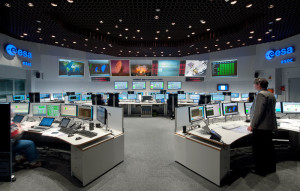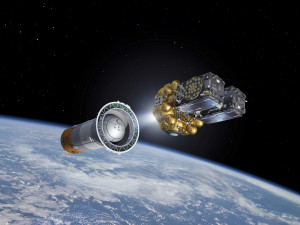When the next pair of Galileo satellites is boosted into orbit next Friday, a team of mission control experts in Darmstadt, Germany, will spring into action, working around the clock to bring the duo through their critical first days in space.
Galileo satellites 9 and 10 are scheduled to lift off at 02:08 GMT (04:08 CEST) on 11 September from Europe’s Spaceport in French Guiana on top of a Soyuz rocket.
This will be the fifth Galileo launch, set to bring the number of satellites in space up to 10. Two more satellites are planned to be launched by year end.
The fiery ascent to space will last just over nine minutes, after which the Fregat upper stage will fire twice to place the satellites into their release orbit.
Separation from Fregat, about 3 hours and 48 minutes into flight, marks the start of the critical early orbits for the team at ESA’s European Space Operation Centre in Darmstadt, Germany.
Within the combined flight control team from ESA and France’s CNES space agency, each position is paired with its counterpart from the other agency and mixed ‘CNESOC’ shifts will rotate to conduct operations around the clock.
The same team conducts all the Galileo early operations alternately from ESOC and from the CNES control centre in Toulouse, France.
“Upon separation, the team will be very focused, and we’ll be watching for a number of critical events on the satellites to happen automatically at the right time and in the right order,” says ESA’s Liviu Stefanov, lead flight director for this phase. “The satellite must switch on, go into a basic flight configuration, deploy its solar wings for power, orient them towards the Sun and acquire Sun-pointing attitude. As soon as we get communications, we’ll check its health and start sending commands to configure the satellite after completion of the automatic sequence and prepare it for the next major activity: pointing Galileo towards Earth.”
The intense activity will begin the 10-day early operations phase, during which the joint team will work 24 hours/day to oversee steps to prepare the satellites for handover to the Galileo Control Centre in Oberpfaffenhofen, for routine operations, and ESA’s Redu Centre in Belgium, for detailed payload testing.
“We must conduct three thruster burns to push each satellite towards its final operational orbit,” says Jérémie Benoist, the co-flight director from CNES. “Like all of our flight control activities, these will require support from experts working in flight dynamics, ground tracking stations and other specialist areas from both ESA and CNES. It truly does take teamwork to ensure Galileo success.”
Even after handing over command and control to the Galileo Control Centre around 21 September, flight dynamics specialists at ESOC will continue supporting the new pair. This will include providing highly accurate orbit determinations and computing orbit manoeuvres, and will continue until the satellites have achieved their operational orbits, around 40 days after launch.
By launch day, the teams will have completed a very demanding series of joint simulation training sessions at ESOC, complemented by more specific training conducted separately at each control centre.
Joint sessions are especially important to develop team bonds ‘on-console’, so individuals get to know who will be working beside them and can foster one-on-one teamwork and mutual support.
“Now, most of the engineers are very familiar with each other, with the mission control systems and with normal Galileo operations, so that means we have been able to focus our training on ‘off-nominal’ situations,” says Liviu.
“We usually finish our training with several completely normal launch simulations. This helps boost team confidence just before launch day, and it’s good psychology.”
As the Galileo series continues, mission operations teams and engineers are applying lessons learned from previous launches. Fixes have included updates to flight procedures, integration of real-life flight data into operational procedures and simulation training, and improvements to the mission control systems.
“The entire team is very motivated and we are ready for the next Galileo launch,” says Paolo Ferri, ESA’s Head of Mission Operations.
“We are proud to be working with our colleagues from CNES and the Galileo Control Centre to ensure a smooth entry into orbit for the next pair of European navigation satellites.”


